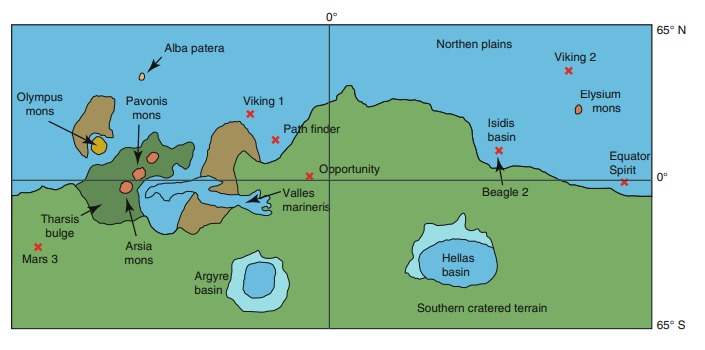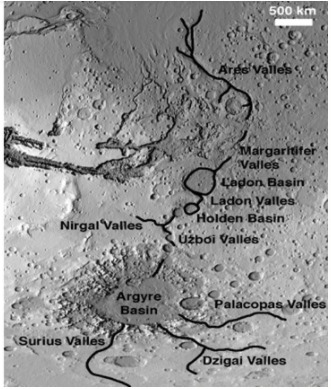Argyre Basin
Sep 06, 2020
Argyre Basin - a riddle to solve the mystery of Martian life
Mars is the fourth planet from the sun. The bright rust color Mars is known for is
due to iron-rich minerals in its regolith the loose dust and rock covering its
surface.The cold, thin atmosphere means liquid water likely cannot exist on the
Martian surface for any length of time. Mirroring conditions of the Late Hadean or Paleoarchean Earth, early Mars
comprised a landmass ;a large ocean, countless crater-hosted lakes, and continental-scale ice sheets; a relatively thick atmosphere,
capable of supporting stable and widespread hydrological activity; and diverse energy sources. Interaction among the landmass, ocean, and atmosphere through
a hydrological cycle driven by internal and external energy sources are considered key to Mars being habitable during its early evolution .
At the surface, early Mars may have supported an Earthlike erosional regime and relatively warmer and wetter conditions
than today, perhaps having prevailing modern Earth-like periglacial/glacial conditions, which may have been sufficient for life to originate and evolve .

Simplified map of geological features on Mars. The shaded area is the northern plain. The lower area is the southern cratered terrain
The Argyre province is a major geological province in the southern cratered highlands of Mars. Geological and hydrological histories have been detailed through a mapping investigation with Viking, Mars Global Surveyor (MGS), Mars Odyssey (ODY), and Mars Reconnaissance Orbiter (MRO) .

A map of the Argyre region and the Chryse trough. Alignment of several valleys and basins along the Chryse trough system were cited as evidence for water
flow from the south polar regions, through the Argyre basin to the northern lowlands
Early Mars is thought to have been relatively habitable . The Argyre impact event occurred during the Late Heavy Bombardment .The impact left an enormous basin,
approximately 1800 km in diameter. The Argyre event occurred at a time when Mars was experiencing major changes in global planetary conditions, including
termination of the internal dynamo, the thinning of the atmosphere, and consequential changes in climate.The Argyre basin is the best-preserved large
multi ringed impact structure on Mars. The giant impact event resulted in the construction of the primary Argyre crater, the uplift of a mountainous rim, and the
production of a complex system of tectonic structures.Evidence for ancient oceans on the northern plains of Mars comes both
from geological and geomorphological analyses and from spectroscopic investigations.
Some specific landscape features in Argyre that are promising sites for astrobiological exploration which include the following:
(1) Hydrothermal deposits
Also including those related to the hydrothermal activity associated with the Argyre impact event, subsequent impacts, and those associated with the migration of
heated water along with Argyle Induced basement structures. The presence of uplifted mantle and lower crustal materials in the basin means that primordial
materials composed of P, K, Al, Ca, Fe, and other elements necessary for life to form may have been exposed to the surface and near-surface environments.
(2) Possible ice-cored mounds(OSPs)
On the basis of the available photogeology, the perennial (water)ice cored mounds within the Argyre basin are recent features, dating from
the Late Amazonian ,and their proposed hydraulic, tectonic, and hydro-tectonic models of formation and functioning involve freeze thaw cycling.
The OSPs within the floor of Argyre basin could be of exceptional astrobiological interest, because the heat gradients
produced hydrothermal activity, which in turn resulted in upwelling processes, enhancing the prospect of fossilized and extant life.

Overview of the site, showing lobes, mantle deposits, and gullies
(3)Sedimentary deposits left behind by glaciers
These along the basins margins as evidenced by ridges interpreted to be eskers . The ridges occur in the Late Hesperian Early Amazonian basin floor deposits and thus are interpreted to be emplaced during this time period, which is coeval with major Tharsis-driven activity . The eskerlike features could be composed of sediment from environments nearby and distant, laid down during glacial outburst floods debouching under confined ice-covered lakes.
(4) Sedimentary deposits related to the formation of lakes
in both the primary Argyre basin and other smaller impact-derived basins along the margin. Lakes could have been formed by the glacial flood outbursts and they would be therefore related to major changes in environmental and hydrological conditions associated with major outgassing of Tharsis during the Late Hesperian and Early Amazonian.
(5) Crater-wall gullies
occurring upslope of the pingo-like mounds. The morphology of the gully landforms points to wet flows, and the crater-wall
structures in which they are embedded could be indicative of groundwater discharge.


